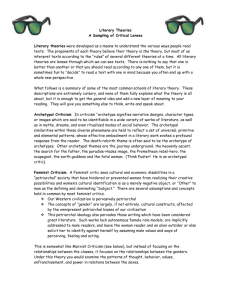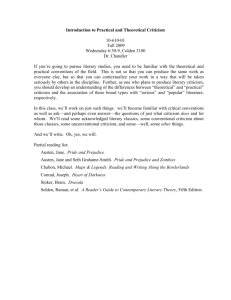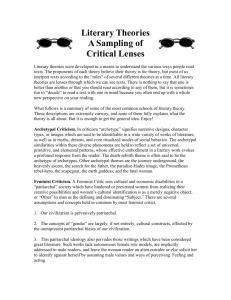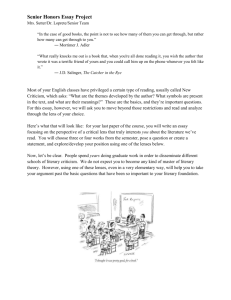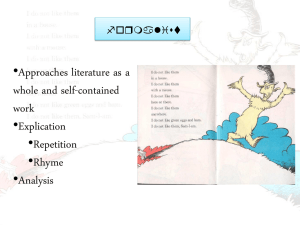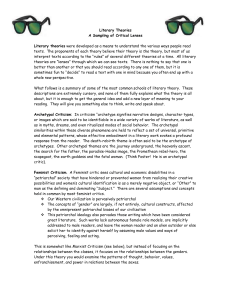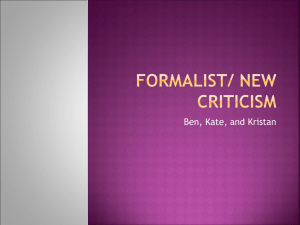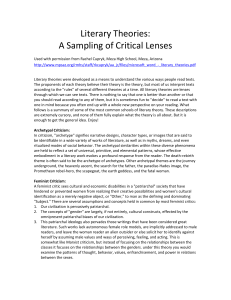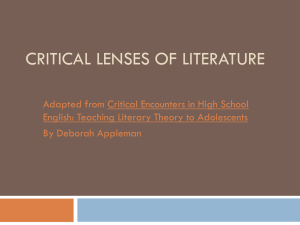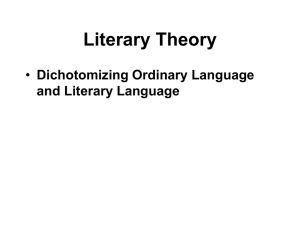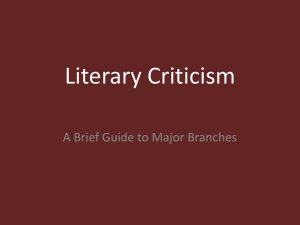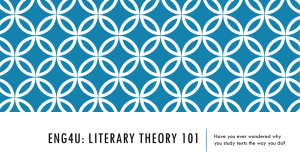File - Adventures in Guinn`s World
advertisement
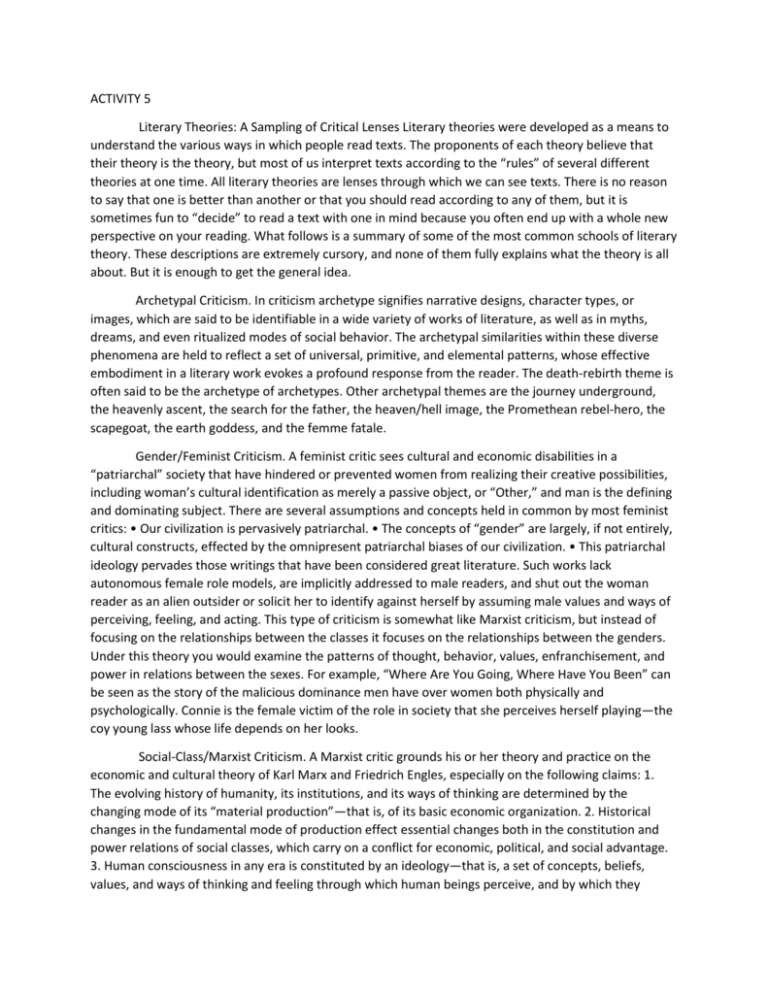
ACTIVITY 5 Literary Theories: A Sampling of Critical Lenses Literary theories were developed as a means to understand the various ways in which people read texts. The proponents of each theory believe that their theory is the theory, but most of us interpret texts according to the “rules” of several different theories at one time. All literary theories are lenses through which we can see texts. There is no reason to say that one is better than another or that you should read according to any of them, but it is sometimes fun to “decide” to read a text with one in mind because you often end up with a whole new perspective on your reading. What follows is a summary of some of the most common schools of literary theory. These descriptions are extremely cursory, and none of them fully explains what the theory is all about. But it is enough to get the general idea. Archetypal Criticism. In criticism archetype signifies narrative designs, character types, or images, which are said to be identifiable in a wide variety of works of literature, as well as in myths, dreams, and even ritualized modes of social behavior. The archetypal similarities within these diverse phenomena are held to reflect a set of universal, primitive, and elemental patterns, whose effective embodiment in a literary work evokes a profound response from the reader. The death-rebirth theme is often said to be the archetype of archetypes. Other archetypal themes are the journey underground, the heavenly ascent, the search for the father, the heaven/hell image, the Promethean rebel-hero, the scapegoat, the earth goddess, and the femme fatale. Gender/Feminist Criticism. A feminist critic sees cultural and economic disabilities in a “patriarchal” society that have hindered or prevented women from realizing their creative possibilities, including woman’s cultural identification as merely a passive object, or “Other,” and man is the defining and dominating subject. There are several assumptions and concepts held in common by most feminist critics: • Our civilization is pervasively patriarchal. • The concepts of “gender” are largely, if not entirely, cultural constructs, effected by the omnipresent patriarchal biases of our civilization. • This patriarchal ideology pervades those writings that have been considered great literature. Such works lack autonomous female role models, are implicitly addressed to male readers, and shut out the woman reader as an alien outsider or solicit her to identify against herself by assuming male values and ways of perceiving, feeling, and acting. This type of criticism is somewhat like Marxist criticism, but instead of focusing on the relationships between the classes it focuses on the relationships between the genders. Under this theory you would examine the patterns of thought, behavior, values, enfranchisement, and power in relations between the sexes. For example, “Where Are You Going, Where Have You Been” can be seen as the story of the malicious dominance men have over women both physically and psychologically. Connie is the female victim of the role in society that she perceives herself playing—the coy young lass whose life depends on her looks. Social-Class/Marxist Criticism. A Marxist critic grounds his or her theory and practice on the economic and cultural theory of Karl Marx and Friedrich Engles, especially on the following claims: 1. The evolving history of humanity, its institutions, and its ways of thinking are determined by the changing mode of its “material production”—that is, of its basic economic organization. 2. Historical changes in the fundamental mode of production effect essential changes both in the constitution and power relations of social classes, which carry on a conflict for economic, political, and social advantage. 3. Human consciousness in any era is constituted by an ideology—that is, a set of concepts, beliefs, values, and ways of thinking and feeling through which human beings perceive, and by which they explain what they take to be reality. A Marxist critic typically undertakes to “explain” the literature of any era by revealing the economic, class, and ideological determinants of the way an author writes. A Marxist critic examines the relation of the text to the social reality of that time and place. This school of critical theory focuses on power and money in works of literature. Who has the power/money? Who does not? What happens as a result? For example, it could be said that “The Legend of Sleepy Hollow” is about the upper class attempting to maintain its power and influence over the lower class by chasing Ichabod, a lower-class citizen with aspirations toward the upper class, out of town. This would explain some of the story’s descriptions of land, wealth, and hearty living that are seen through Ichabod’s eyes. New Criticism is directed against the prevailing concern of critics with the lives and psychology of authors, with social background, and with literary history. There are several points of view and procedures that are held in common by most New Critics: 1. A poem should be treated as primarily poetry and should be regarded as an independent and self-sufficient object. 2. The distinctive procedure of the New Critic is explication, or close reading: the detailed and subtle analysis of the complex interrelations and ambiguities of the components within a work. 3. The principles of New Criticism are fundamentally verbal. That is, literature is conceived to be a special kind of language whose attributes are defined by systematic opposition to the language of science and of practical and logical discourse. The key concepts of this criticism deal with the meanings and interactions of words, figures of speech, and symbols. 4. The distinction between literary genres is not essential. Psychological and Psychoanalytic Criticism. Psychological criticism deals with a work of literature primarily as an expression, in fictional form, of the personality, state of mind, feelings, and desires of its author. The assumption of psychoanalytic critics is that a work of literature is correlated with its author’s mental traits: 1. Reference to the author’s personality is used to explain and interpret a literary work. 2. Reference to literary works is made in order to establish, biographically, the personality of the author. 3. The mode of reading a literary work itself is a way of experiencing the distinctive subjectivity or consciousness of its author. This theory requires that we investigate the psychology of a character or an author to figure out the meaning of a text (although to apply an author’s psychology to a text can also be considered biographical criticism, depending on your point of view). For example, alcohol allows the latent thoughts and desires of the narrator of “The Black Cat” to surface in such a way that he ends up shirking the self-control imposed by social mores and standards and becomes the man his psyche has repressed his whole life. Reader Response Criticism. This type of criticism focuses on the activity of reading a work of literature. Reader response critics turn from the traditional conception of a work as an achieved structure of meanings to the responses of readers to the text. By this shift of perspective a literary work is converted into an activity that goes on in a reader’s mind, and what had been features of the work itself—narrator, plot, characters, style, and structure—is less important than the connection between a reader’s experience and the text. It is through this interaction that meaning is made. Students seem most comfortable with this school of criticism. Proponents believe that literature has no objective meaning or existence. People bring their own thoughts, moods, and experiences to whatever text they are reading and get out of it whatever they happen to, based on their own expectations and ideas. For example, when I read “Sonny’s Blues” I am reminded of my younger sister who loves music. The story really gets to me because sometimes I worry about her and my relationship with her. I want to support her and am reminded of this as I see that Sonny’s brother does not support Sonny. Other theories we’ll be discussing in class include the following: Deconstructionist Criticism. Deconstruction is by far the most difficult critical theory for people to understand. It was developed by some very unconventional thinkers, who declared that literature means nothing because language means nothing. In other words, we cannot say that we know what the “meaning” of a story is because there is no way of knowing. For example, in some stories (such as Joyce Carol Oates’s “Where Are You Going, Where Have You Been?”) that do not have tidy endings, you cannot assume you know what happened Historical Criticism. Using this theory requires that you apply to a text specific historical information about the time during which an author wrote. Historical, in this case, refers to the social, political, economic, cultural, and intellectual climate of the time. For example, William Faulkner wrote many of his novels and stories during and after World War II, a fact that helps to explain the feelings of darkness, defeat, and struggle that pervade much of his work. Classroom Activities 153
